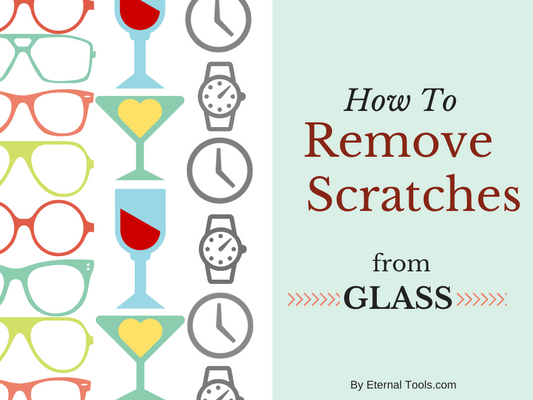Please note: These methods are not suitable for tempered glass or windshields. In those cases, replacement or specialist repair is recommended, as the glass may crack or distort the view.
Caution: Always test on a spare piece of glass or stone before working on your final piece. These abrasives remove material, and over-polishing can cause distortion if not done carefully.
For glass scratch removal from fused glass, engraved glass, blown glass, household glass objects, watch glass or jewellery pieces, cabochons and gemstones, here are a few options for removing those unwanted marks and scratches from your glass.
Option 1: Diamond Polishing Paste
Diamond polishing paste (also called diamond grinding paste or diamond compound) is our preferred solution for scratch removal. It is measured in microns (µm) and comes in a range of grades for different stages of polishing.
Which micron to use? For coarse scratches, start with a 6–14µm paste, then work down to 3µm and finish with 1µm. Stubborn stove glass scratches respond well to 14µm paste. For light scratches and final polishing, use 1µm or 0.25µm to achieve a mirror finish.
If you only use a fine paste (e.g. 1µm) on a deep scratch, it will eventually work but will take much longer. Ideally, keep a few different grades in your toolkit so you can progress through them more efficiently.

The depth of the scratch will determine what grade of paste to use. A very deep scratch for instance will require a coarser paste to begin with followed by finer pastes thereafter until the desired effect of surface finish is achieved.
How to Use Diamond Polishing Paste
Step 1: Attach a felt bob, calico wheel or cotton mop to your rotary tool, or apply to a lapidary wheel or belt. You can also use leather, pegwood, or plastic for very fine grades.
Step 2: Apply a small dab of paste to your applicator. Use a coarser paste for deeper scratches and a finer paste for hairline marks.
Step 3: Work progressively through different grades. Start with coarse paste, then polish up with finer grades until the scratch disappears. Begin at a low speed on your rotary tool and increase gradually if needed.
Step 4: If you prefer, you can dab diamond paste onto leather or flexible plastic and polish by hand. This method will require some elbow grease! but works well on watch glass, antique glass, glass engravings and gemstones.
Our diamond polishing paste comes in 5g syringes, ready to use with no extra mixing required.
Option 2: Cerium Oxide
Cerium oxide powder is another option for polishing and brightening glass. It is excellent for light marks and surface blemishes. However, if you can feel the scratch with your fingernail, diamond paste will be more effective.
Mix cerium oxide with warm water into a paste. Apply by hand using a cloth or sponge, or use it with a felt wheel or bob in a rotary tool at slow speed. Add more cerium oxide paste as it dries out, and moisten the felt with water if needed.
Mix 2 x parts cerium oxide with 1 x part warm water.
If you want a more aggressive paste, mix with only a little water to form a creamy paste. If you are looking to only polish the glass surface, then mix with more water to a thin slurry.

Option 3: EVE Diapol Diamond Polishers
EVE Diapol diamond polishers are mess-free and long-lasting and can be used as a 3-step polisher to achieve a superior finish in seconds!
They come in 3 colours/grades:
Green: Reducing, removing and shaping (Medium, approx. 35µm)
Grey: Smoothing and pre-polish (Fine, approx. 4–8µm)
Pink: High lustre polishing (Extra Fine, approx. 1–2µm)
Make sure to use our recommended screw mandrel with your wheel and knife edge shaped polishers and the 3mm Pin Mandrel with the Pointed Pin shape. They are specifically designed to be used with these. Other mandrels may cause the polisher to split or fly off when in use. Use at a recommended speed of 7,000-10,000 RPM.
Clean and remove any foreign materials and refresh the diamond abrasive with a Diamond Dresser. This will ensure a sharper, clean cutting edge each time.

Option 4: Rubber Silicone Polishers
For very light marks, rubber silicone polishers are another option. These are best for polishing away fine blemishes rather than deeper scratches. If the scratch can be felt with your fingernail, use diamond paste instead.
Attach the correct mandrel to your rotary drill. Start with a medium-grade polisher such as black, then move to blue (fine) and finish with pink (extra fine) until the surface is smooth. Keep the tool speed between 7,000–10,000 RPM.
Helpful note: These EVE silicone polishers are commonly used to polish metals for your jewellery work as well as add depth to glass engraving and polish cabochons. However, they are also useful for numerous jobs around the home such as removing paint from door handles, hinges and fixtures and fittings.
Other Alternatives
You may have heard that toothpaste can remove scratches from glass. In reality, toothpaste is too mild. It may fill a scratch temporarily but will not remove it effectively. It is best kept for one's teeth!
For plastic watch crystals, use Polywatch, which is specially designed for plastic glass scratch removal.
Each of these methods has its place depending on the type of glass and the depth of scratch. For the most reliable and versatile results, Diamond Polishing Paste remains our top recommendation.


